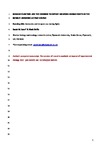Immune function and the decision to deploy weapons during fights in the beadlet anemone Actinia equina.
| dc.contributor.author | Lane, Sarah | |
| dc.contributor.author | Briffa, Mark | |
| dc.date.accessioned | 2018-02-22T11:27:21Z | |
| dc.date.issued | 2018-02-20 | |
| dc.identifier.issn | 0022-0949 | |
| dc.identifier.issn | 1477-9145 | |
| dc.identifier.other | ARTN jeb169201 | |
| dc.identifier.uri | http://hdl.handle.net/10026.1/10842 | |
| dc.description.abstract |
The ability to mitigate the costs of engaging in a fight will depend on an individual's physiological state. However, the experience of fighting itself may in turn affect an individual's state, especially if the fight results in injury. Previous studies found a correlation between immune state and fighting success, but the causal direction of this relationship remains unclear. Does immune state determine fighting success? Or does fighting itself influence subsequent immune state? Using the beadlet anemone Actinia equina, we disentangle the cause and effect of this relationship, measuring immune response once pre-fight and twice post-fight. Contrary to previous findings, pre-fight immune response did not predict fighting success, but rather predicted whether an individual used its weapons during the fight. Furthermore, weapon use and contest outcome significantly affected post-fight immune response. Individuals that used their weapons maintained a stable immune response following the fight, while those that fought non-injuriously did not. Furthermore, although winners suffered a similar reduction in immune response to losers immediately post-fight, winners began to recover pre-fight levels within 24 hours. Our findings indicate that immune state can influence strategic fighting decisions and moreover that fight outcome and the agonistic behaviours expressed can significantly affect subsequent immunity. | |
| dc.format.extent | jeb169201- | |
| dc.format.medium | Electronic | |
| dc.language | en | |
| dc.language.iso | en | |
| dc.publisher | Company of Biologists | |
| dc.subject | Actinia equina | |
| dc.subject | Contest behaviour | |
| dc.subject | Fighting success | |
| dc.subject | Immune response | |
| dc.subject | Injuries | |
| dc.subject | Weapon use | |
| dc.title | Immune function and the decision to deploy weapons during fights in the beadlet anemone Actinia equina. | |
| dc.type | journal-article | |
| dc.type | Journal Article | |
| dc.type | Research Support, Non-U.S. Gov't | |
| plymouth.author-url | https://www.ncbi.nlm.nih.gov/pubmed/29361588 | |
| plymouth.issue | 4 | |
| plymouth.volume | 221 | |
| plymouth.publication-status | Published online | |
| plymouth.journal | Journal of Experimental Biology | |
| dc.identifier.doi | 10.1242/jeb.169201 | |
| plymouth.organisational-group | /Plymouth | |
| plymouth.organisational-group | /Plymouth/Faculty of Science and Engineering | |
| plymouth.organisational-group | /Plymouth/Faculty of Science and Engineering/School of Biological and Marine Sciences | |
| plymouth.organisational-group | /Plymouth/REF 2021 Researchers by UoA | |
| plymouth.organisational-group | /Plymouth/REF 2021 Researchers by UoA/UoA04 Psychology, Psychiatry and Neuroscience | |
| plymouth.organisational-group | /Plymouth/Research Groups | |
| plymouth.organisational-group | /Plymouth/Research Groups/Marine Institute | |
| plymouth.organisational-group | /Plymouth/Users by role | |
| plymouth.organisational-group | /Plymouth/Users by role/Academics | |
| plymouth.organisational-group | /Plymouth/Users by role/Researchers in ResearchFish submission | |
| dc.publisher.place | England | |
| dcterms.dateAccepted | 2017-12-21 | |
| dc.rights.embargodate | 2019-2-20 | |
| dc.identifier.eissn | 1477-9145 | |
| dc.rights.embargoperiod | Not known | |
| rioxxterms.versionofrecord | 10.1242/jeb.169201 | |
| rioxxterms.licenseref.uri | http://www.rioxx.net/licenses/all-rights-reserved | |
| rioxxterms.licenseref.startdate | 2018-02-20 | |
| rioxxterms.type | Journal Article/Review | |
| plymouth.funder | The role of additive and non-additive genetic effects during animal contests in the beadlet sea anemone Actinia equina::BBSRC |


